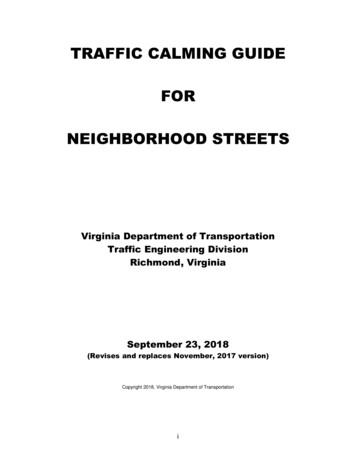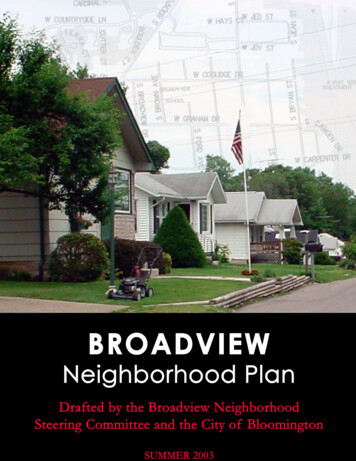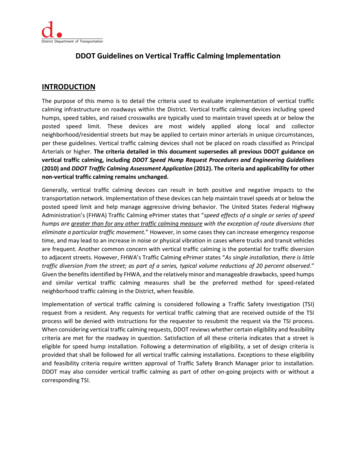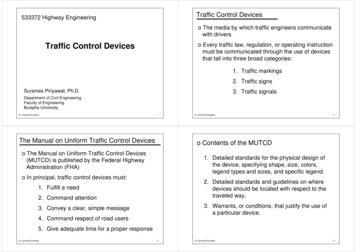
Transcription
TRAFFIC CALMING GUIDEFORNEIGHBORHOOD STREETSVirginia Department of TransportationTraffic Engineering DivisionRichmond, VirginiaSeptember 23, 2018(Revises and replaces November, 2017 version)Copyright 2018, Virginia Department of Transportationi
TABLE OF CONTENTSPAGEI. INTRODUCTION & OVERVIEW. 1II. TRAFFIC CALMING ROLES & PROCESS. 1Step 1 - Initial Contact & Review . 4Step 2 - Study Request. 4Step 3 - Engineering Review. 4Step 4 - Plan Development. 5Step 5 - Community Meeting & Ballot survey. 5Step 6 - Local Government Endorsement. 6Step 7 – Consideration for Implementation. 7Step 8 – Evaluation. 7Modification of Traffic Calming DevicesIII. TRAFFIC CALMING MEASURES1. Non-Intrusive Measures. 8. 8. 8Community Education. 9Community Gateway. 9Pavement Markings .11Speed Display Signs. 15 200 Additional Fine Signs. 162. Vertical, Horizontal and Narrowing MeasuresSpeed Hump. 17 . 19ii
Speed Lump . 20Speed Table. 22Raised Intersection. 24Raised Crosswalk. 26Chicane. 27Median Island . 31Crosswalk Refuge. 32Choker . 34Curb ExtensionIV. COMBINED MEASURESV. MEASURES NOT INCLUDEDREFERENCES. 36. 37. 37. 40APPENDIX:DEVELOPMENT & IMPLEMENTATION OF THE TRAFFIC CALMING PLAN . 42iii
TRAFFIC CALMING GUIDE FOR NEIGHBORHOOD STREETSI.INTRODUCTION & OVERVIEWThe “Traffic Calming Guide for Neighborhood Streets” (hereafter referred to as TheGuide) replaces VDOT’s previous “Traffic Calming Guide for Local Residential Streets.”The Guide provides guidance and procedures for a local community to pursue trafficcalming in their neighborhoods on streets maintained by VDOT.The purpose of traffic calming is to lower vehicle speeds on neighborhood streets withoutrestricting access. Traffic calming measures may also alleviate other issues such as cutthrough traffic or through-truck traffic, where motorists or truckers, use neighborhoodstreets to avoid and bypass other nearby roads. Where there are persistent issues withthrough-truck traffic the “Through truck Restriction” program provides a process forrestricting such traffic, munityPrograms.asp for moreinformation).The Guide reflects a restructured process where local residents of the community, theHome Owners Association (HOA) or the Civic Association (CA) initiate a request for trafficcalming and study. County or Town staff (where traffic calming is taking place within atown) work with the local community to conduct the traffic calming process, workingthrough the Board of Supervisors or the Town Council, as appropriate. VDOT’sinvolvement focuses on confirming the appropriateness of the community efforts at criticalpoints in the process and coordinating the implementation of the approved plan.The Guide focuses on existing streets. Ideally, new residential developments wouldimplement traffic calming concepts within the initial roadway design such as horizontalalignment shifts, narrower lanes etc. Various traffic calming measures in the Guide maybe options as well. The design & review of development plans for new subdivisions shouldidentify and address traffic management concerns and incorporate geometric designs andtraffic calming concepts that make streets less desirable for speeding and cut-throughtraffic.II.TRAFFIC CALMING –ROLES & PROCESSRoles of Local Government, Community & VDOTLocal Government: County or Town staff (generally referred to as the Locality in theGuide) work with the local community and through the Board of Supervisors (BOS) orTown Council (where traffic calming is taking place within a town), to guide andimplement the traffic calming process and plan development (Steps 1 – 6 in Figure 1).VDOT: VDOT representatives confirm the eligibility and feasibility of streets proposedfor traffic calming and the proposed traffic calming plan and; coordinates1 Page
implementation as appropriate (Steps 1, 3, 4, 7 and 8 in Figure 1). In Fairfax, PrinceWilliam, and Loudoun Counties, the Northern Virginia District Traffic Engineer’s (DTE)office is the primary liaison for traffic calming. For all other areas of the state, the localResident Engineer/Administrator (RA) is the primary liaison to the community for trafficcalming; and coordinates with the DTE’s office as appropriate for the various processes.The Traffic Calming ProcessThe process for traffic calming is below (see Figure 1) with the details for each step laidout on the subsequent pages.2 Page
FIGURE 1 - THE TRAFFIC CALMING PROCESSStep 1Initial Contact & ReviewStep 2Traffic Calming Study RequestStep 3Engineering Study/ReviewStep 4Traffic Calming Plan DevelopmentStep 5Community Support / ApprovalStep 6BOS or Town Council EndorsementStep 7Consideration for implementationStep 8Evaluation3 Page
Step 1: Initial Contact & ReviewTo begin a traffic-calming project, local community members contact the BOS or theTown Council. The Locality confirms with VDOT that the street proposed for trafficcalming meet the basic eligibility requirements for VDOT’s traffic calming program,which are:1. Street is in the state system of highways owned and maintained by VDOT.2. Street is within a neighborhood setting where the residences and businessesface the street rather than reverse-frontage (where houses along a street do notface or generally have access to the street). A typical neighborhood street fortraffic calming is a secondary road within a subdivision with a high density ofresidences and a functional classification of “local”.3. Street has a posted speed limit of 25 mph or less. Unposted, residential streetssuch as within a subdivision generally have a statutory speed limit of 25 mphhowever; the applicable speed limit must be confirmed with VDOT.Step 2: Traffic Calming Study RequestAfter confirming the street meets the basic eligibility requirements for traffic calming, theHome Owners Association (HOA) or Civic Association (CA) gets approval from theBoard of Supervisors or the Town Council to pursue traffic calming on the proposedstreet, conduct an engineering review and pursue a traffic calming study. If there is notan HOA or CA a minimum of 10 residents (or 10% of residents) along the street maysecure approval from the BOS. Upon agreement by the Board of Supervisors or theTown Council to pursue traffic calming on the requested street, they proceed to Step 3.Step 3: Engineering study/reviewThe Locality conducts an engineering review, speed study and traffic count as follows todetermine if the street is suitable for traffic calming and document important relatedfeatures.i.ii.iii.An engineering field review determines the suitability of the street for trafficcalming considering the extent of horizontal curves and grades and any relatedsight distance issues, roadway drainage appurtenances, extent and location ofroad access points etc. that may affect the location, extent and type of trafficcalming implemented.A speed study determines the operating speed (typically via the 85th percentilemethod). In order to be eligible for further consideration of traffic calming thestreet must have an operating speed 10 mph or more above the speed limit (e.g.35 mph or more where the speed limit is 25 mph) in at least one travel direction.The level of traffic determines the type & extent of traffic calming considered. Atraffic count is conducted to determine the average daily traffic (ADT) volumeincluding both travel directions. A traffic count conducted for a period of 48-hours,on a Wednesday and Thursday is the common practice in order to capture the4 Page
---average daily traffic. Traffic counts on other days of the week are more likely torepresent non-typical traffic, particularly weekends.Streets with a daily traffic volume between 600 and 4,000 vehicles per day (VPD)are appropriate for consideration of the full range of traffic calming measures inthe Guide.Streets with less than 600 VPD may be a consideration for some of the lowercost non-intrusive actions such as community education and the Additional 200Fine Signs. Other non-intrusive options can be quite costly such as communitygateways, pavement marking schemes (depending on the type/extent ofmarkings) and speed display signs.Where traffic volumes on the study street exceed 4,000 VPD the Additional 200Fine Signs or Speed Display signs can be used under the specific programs forthose signs, outside the traffic calming program (see pp. 16-17). Some of themeasures in the Guide can likewise be used on higher volume roads and may beoptions to pursue outside the traffic calming program as well. These are CornerExtension/Bulbouts, Chokers, Median Islands, On-Street Parking and RoadDiets.VDOT reviews the study results, confirms the appropriateness of the street for trafficcalming and notes any items or limitations etc. that should be considered in developingthe traffic calming plan.Step 4: Traffic Calming Plan DevelopmentThe Locality, in coordination and consultation with VDOT, next develops a conceptualtraffic calming plan following the requirements and considerations laid out in APPENDIXI: Development & Implementation of the Traffic Calming Plan. This section lays out thevarious considerations for the selection, location, installation, operation andmaintenance aspects of the various traffic calming devices.Agreement must be secured for each affected property owner of a residence orbusiness where the physical location of a proposed traffic calming device or someportion (excluding warning signs posted for a device) lies within the roadway frontage ofthe property boundary. Note: the affected property owner may agree to the deviceaffecting their property without agreeing with the entire traffic calming plan. Where aparticular property owner does not concur with a particular device as it affects theirproperty, other options such as shifting the location or proposing an alternate deviceshould be considered.Step 5: Community Support / ApprovalPrior to soliciting community approval, the Locality identifies the survey area,coordinating with the local community, HOA, CA the District Supervisor’s or TownCouncil and VDOT. The survey area comprises (i) residences and businesses on thestreet identified for traffic calming and (ii) residences and businesses on other streets5 Page
whose sole or primary access is the street identified for traffic calming and who wouldbe considerably inconvenienced if they chose an alternate route.The proposed traffic calming plan, along with the supporting information below, ispresented or provided to the community within the survey area for their review for asufficient period of time (a minimum of 30 days is suggested). This may be through apublic meeting(s) and/or electronic/postal distribution, or some other means orcombination thereof that serves to inform the community of the proposal.Supporting Information:(i)A map that that indicates the location and approximate footprint of theproposed traffic calming devices along the street and the affected propertyboundaries.A map that indicates the survey area including residences, businesses andthe connecting streets.Information about the nature and features of the proposed traffic-calmingdevices such as contained in the Guide.The process and procedures that will be used to measure and documentcommunity support (e.g. petition, ballot survey etc.).(ii)(iii)(iv)To measure and document community support the Locality conducts a petition, survey,or other process that ensures the accurate measure and documentation of support.The measure and documentation of support shall hold to the following:-Only occupied residences or businesses in the survey area are included/countedin measuring and documenting community support (e.g. signing a petition fortraffic calming, cast a ballot/vote etc.).Each residence or business address gets a single signature or ballot/vote etc. toindicate agreement or disagreement with the entire plan.More than 50% of the occupied residences or businesses in the survey areamust support the traffic calming plan in order for the plan to be implemented.Step 6: County Board of Supervisors or Town Council EndorsementUpon approval by the community of the proposed plan, the BOS or Town Councilendorses the plan by a resolution. The resolution should state the following:(i)(ii)(iii)6 PageThe proposed Traffic Calming Plan was properly presented to the communityin the affected survey area for their review and considerationThe plan was subsequently approved by (indicate percentage) of theoccupied residences and businesses within the appropriate surveyed areaThe intended source of funding (e.g. 50% secondary highway funds, 50%local funds).
The resolution and traffic calming plan is then conveyed to VDOT along with thefollowing related documentation:(i)(ii)(iii)(iv)The engineering study/reviewA map depicting the streets and residences identified as part of the surveyareaA description of the method used to measure and document communitysupport (e.g. petition, survey etc.)The survey documents and a summary of the survey results including thenumber of residences and businesses in the survey area and thenumber/percentage that support the proposed plan.Step 7: Consideration for Implementation –VDOTAfter reviewing and confirming the proposed plan, BOS resolution and survey results,VDOT will consider implementation of the traffic calming plan through VDOT contractforces or the Locality. The implementation of the plan by VDOT forces is dependent ontheir funding priorities and availability of resources, materials and equipment.Preferably, the Locality will implement the traffic calming plan where such anarrangement is acceptable to VDOT.FundingSecondary or locality-provided funds are the primary sources for funding. The Localityshould consult with the BOS and the local VDOT residency office to determine use ofappropriate funds. Note that streets subject to VDOT’s Secondary Street AcceptanceRequirements (SSAR) - generally, those subdivision streets where plats and plans weresubmitted to the local government and VDOT on or after July 1, 2009 - are not eligiblefor VDOT funds on any portion of the street width that exceeds that specified inAppendix B (1) of VDOT’s Road Design Manual. To illustrate, on a subdivision street 36feet wide where a minimum street width of only 29 feet is required by the SSARstandards VDOT funds for the cost of materials, construction and maintenance mayonly be applied for 29 feet of the total 36 feet width or 80 ½ % of the total cost. Theremaining 19 ½ % of construction and maintenance costs must be funded entirely bythe locality.Step 8: Evaluation -VDOTFollowing construction of the traffic calming plan, VDOT will review the installation andthe related traffic control devices to ensure that there is no safety, operational, ormaintenance issue.Subsequent to installation (after 3 months is suggested), a follow-up review may beconducted to evaluate the effectiveness of the traffic calming measures in reducing theoperating speeds or any safety issues etc. VDOT may wish to disseminate any findings7 Page
and recommendations from such reviews through the Board of Supervisors in order toobtain feedback from those involved in the plan development.Modification of Installed Traffic Calming DevicesWhere a safety, maintenance, or operational issue arises following installation of atraffic calming device(s) VDOT or the Locality (where they installed the devices) mayadjust, relocate or remove the relevant traffic calming device(s) as necessary to addressthe issue, with the same funding sources used to install the devices originally. TheLocality must confirm the issue and any proposed changes with VDOT prior to theiradjusting, relocating or removing a traffic calming device(s).Where the Locality proposes to adjust, relocate or remove a traffic calming device(s) forother than a safety, operational, or maintenance issue they must use their secondary orlocal funds, secure (re)approval of the affected residents and likewise confirm theproposed changes with VDOT.III.TRAFFIC CALMING MEASURESThe traffic calming devices included in The Guide are characterized as Non-Intrusive orVertical, Horizontal and Narrowing devices and are discussed on the following pages.1.Non-Intrusive Traffic Calming DevicesNon-intrusive measures include administrative measures such as a public informationcampaign, posting certain types of signs to promote speed reduction, and utilizingpavement markings to reduce the number of lanes and/or pavement travelway widths.The additional pavement width available through the various reductions can bereallocated for parking lanes, bike lanes, or sidewalks etc.The Non-intrusive devices offer the advantage that they do not physically constrainvehicle maneuvers and thus are less invasive. This is particularly desirable for streetsthat serve as major emergency and bus routes. Other desirable aspects of the nonintrusive devices are that they involve standard signs and pavement markings easilyrecognized by motorists and; can generally be less costly overall than the vertical,horizontal and narrowing measures.However, some non-intrusive applications are not as effective because they do notphysically constrain vehicles to reduce speed.The following describes the features of the Non-intrusive devices regarding theirplacement, advantages/disadvantages, effectiveness and costs. The non-intrusivemeasures included in the Guide are Community Education, Community Gateways,Pavement marking measures, Speed Display Signs and Additional 200 Fine signs.8 Page
Non-Intrusive Devices -Community EducationInforming and reminding the community of speeding issues and concerns and theimportance of driving safely in their neighborhood is an important step. Variousresources and literature are available to inform the community on these various issues.The Virginia Department of Motor Vehicles (DMV) has considerable literature andinformation on all aspects of safety including speeding and aggressive driving, schoolbus safety, bicyclists, pedestrians, teen drivers, mature drivers etc. which can serve toeducate both motorists and pedestrians/bicyclists alike and raise the overall awarenessof safety. See DMV’s site at x.aspfor this information.Similarly, the “Virginia 2017-2021 Strategic Safety Highway Safety Plan” available A 2017 SHSP Final complete.pdfprovides extensive information on aspects of safety related to speeding and pedestriansin Virginia and strategic efforts to address these issues.VDOT’s “Bicycling and Walking in Virginia” web page ult.asp covers the safety and legalaspects of bicyclists and pedestrians in Virginia.Non-Intrusive Devices -Community GatewaysFigure 1.1 – Community Gateway9 Page
Figure 1.2 - Community GatewayDescriptionCommunity Gateway treatments involve the combined use of sign installations,landscaping, textured pavements, name plates, monuments, or other arrangementsplaced at the entrance to a neighborhood to communicate a sense of neighborhoodidentity. The installations serve to inform motorists they are entering a community wherethere is a significant change in the driving environment such as a transition from a ruralor urban road a residential street.Note: Funds for landscaping-related items for a gateway treatment may be limited to aminimal percentage of the construction funds budgeted for a proposed traffic calmingplan with the remaining funds required provided by the locality. In addition, theneighborhood association or other community group would be solely responsible forongoing maintenance of landscaping-related items.PlacementThe gateway is placed at the entrance or “gateway” to the community at a prominentlocation and should be large enough to attract the attention of motorists and toeffectively communicate they are entering the neighborhood or community.Advantages:Provides an attractive addition to a community.Disadvantages10 P a g e
- Generally, requires ongoing maintenance such as painting, renewing and wateringthe vegetation or possibly repairs. The neighborhood association or other communitygroup would be responsible for maintaining these installations.EffectivenessFHWA (Federal Highway Administration “Engineering Countermeasures to ReduceSpeeds” –see references) indicates an average reduction in operating speeds of about2 mph.CostThe cost of gateways varies significantly according to the features included and theextent of the construction.Non-Intrusive Devices -Pavement MarkingsFigure 2.1 –Pavement Marking Options11 P a g e
Figure 2.2 –Narrow travelway by re-striping pavementFigure 2.3 - Narrow travelway by re-striping to add parallel parking lanes12 P a g e
Figure 2.4 – Narrow travelway by re-striping pavement for a bike laneDescriptionThe pavement marking options are used in various ways to narrow the vehicle travellanes, which tends to make motorists drive slower. These include striping the shoulderand/or centerline to narrow the travel lanes (per north and south legs of intersection inFigure 2.1) or adding parking and/or bicycle lanes (per east and west legs ofintersection in Figure 2.1 and depicted in Figure’s 2.2 – 2.4). The addition of parking tonarrow the travelway (particularly parallel parking) can have a pronounced effect onspeed, particularly on a narrow two-way street with parking on both sides where parkedvehicles occupy one-half or more of the block. One option when adding parking lanes isto alternate parking along opposite sides of the street which introduces a physicalchange in the straight vista of a roadway, similar to that of a chicane (discussed furtheron) to promote reduced speeds.“Road diets” likewise incorporate markings to narrow and/or eliminate travel lanesalthough the common application (conversion of a high traffic, undivided four-laneroadway to a three-lane roadway with two through lanes and a center two-way left-turnlane) is not relevant on a typical neighborhood street, the focus of the Guide.Note: On local streets, bicyclists are considered a normal part of the vehicle mix and donot necessarily require a marked or designated bike lane which is more appropriate on13 P a g e
collector roads and where they connect to a network of bike lanes on streets identifiedin a local and/or regional Bicycle Plan.PlacementThe desired features (e.g. add bike lanes and/or parking etc.) and available pavementwidth as well as the allowable minimum travelway widths (see Appendix I –Selection ofMeasures), dictates the type of pavement striping and its location.Advantages-Does not physically restrict driver maneuvers and thus will not impose speedreductions on emergency and transit vehiclesInvolves a standard traffic control device easily recognizable by motoristsCan be less costly to implement than some of the other devices depending on theetype and extent of applicationDisadvantagesRestriping the pavement involves considerably more effort where significant eradicationof existing pavement markings is required. Therefore, where this is the case it isrecommended that this measure is implemented in conjunction with a re-paving project.EffectivenessFHWA suggests a reduction between 1 and 5 mph (a reduction of 2 to 3 mph being themost common) where parallel parking is added to narrow the travelway and a reductionof ½ mph where shoulder markings are used to narrow the travel lane.CostAn estimated cost of 5 per linear foot of pavement marking/striping, includingeradication of existing markings and maintenance of traffic, is suggested. Specialsymbols such as bicycle emblem on a bike lane are approximately 300 each.14 P a g e
Non-Intrusive Devices -Pole Mounted Speed Display (PMSD) SignFigure 3.1 –Pole Mounted Speed Display SignDescriptionA Pole Mounted Speed Display (PMSD) Sign combines the regulatory speed limitsign with a radar speed feedback sign that displays the real-time speed of anapproaching vehicle which tends to make motorists reduce their speed.PlacementSigns are installed only on streets with a single through-travel lane per travel direction(e.g. a two-lane, two-way or one-lane, one-way street). Generally, one sign is placed atthe beginning of the street section identified for traffic calming in each travel direction, inorder to reinforce the posted speed limit for vehicles entering the section of streetdesignated for traffic calming. At least 200 feet of visibility distance should be allowedapproaching the sign and at least 100 feet between any other signs.Advantages-These signs can potentially be used as a portable assembly that allows forplacement at alternating locations.15 P a g e
-Does not physically restrict driver maneuvers and thus will not impose speedreductions on emergency and transit vehicles.Involves a standard traffic control device easily recognizable by motorists.DisadvantagesInstalling these signs may be impacted by the availability of a power source.EffectivenessVarious sources indicate an average sustained reduction in operating speeds of 5 mphmay be achieved.CostAn estimated cost of 7,500 per installation is suggested, depending on whether solaror conventional power is used as well as the proximity of the power source.Non-Intrusive Devices -Additional 200 Fine SignsFIGURE 4.1 –Additional 200 Fine Sign16 P a g e
DescriptionThe Additional 200 Fine Signs, when properly implemented and posted on aresidential street, impose a 200 fine for speeding in addition to the typical fine. Thesesigns must follow the requirements of VDOT’s policy FINAL POLICY ADDL FINE June 171999.pdf ) which requires a formal acceptance process including a request by resolutionof the local governing body for the signs, verification that there is a speeding problemand that the increased penalty has community support. The full requirements are metfor these signs when identified and approved for traffic calming per the Guide.PlacementThese signs are installed in conjunction with the posted speed limit sign and are placedat the beginning of the roadway section in each travel direction where the higher fineswill apply. At least 200 feet of visibility distance should be provided approaching the signand at least 100 feet between any other signs.Advantages-Does not physically restrict driver maneuvers and thus will not impose speedreductions on emergency and transit vehicles.Involves a standard traffic control device easily recognizable by motorists.DisadvantagesThe effectiveness of these signs in reducing vehicles speeds is unknown.EffectivenessThe effectiveness of these signs is unknown.CostThe estimated cost for installing these signs, which consists of producing and installingthe posted speed limit sign and the supplemental “Additional 200 Fine” plaque, is 750per sign. The minimum estimated cost to install these signs on a street designated forthe additional 200 fines is 3,000 (a total of four signs, two per travel directionindicating the beginning and ending of the additional fine street section).2.Vertical, Horizontal and Narrowing DevicesThese are traffic calming devices constructed and installed on the street pavementsurface to narrow the travelway or create vertical or horizontal shifts on the roadway.These devices can be particularly effective in slowing vehicles because they physically17 P a g e
constrain vehicles to pass over, through or around physical obstructions on theroadway.Vertical, Horizontal, and Narrowing devices can also significantly affect emergencyresponse (as well as transit) times; from three to ten seconds per device depending onthe type of device and the vehicle traversing it; with the delay compounded by multipledevices.Although neighborhood streets do not generally serve as primary em
street must have an operating speed 10 mph or more above the speed limit (e.g. 35 mph or more where the speed limit is 25 mph) in at least one travel direction. iii. The level of traffic determines the type & extent of traffic calming considered. A traffic count is conducted to determine the average daily traffic (ADT) volume










